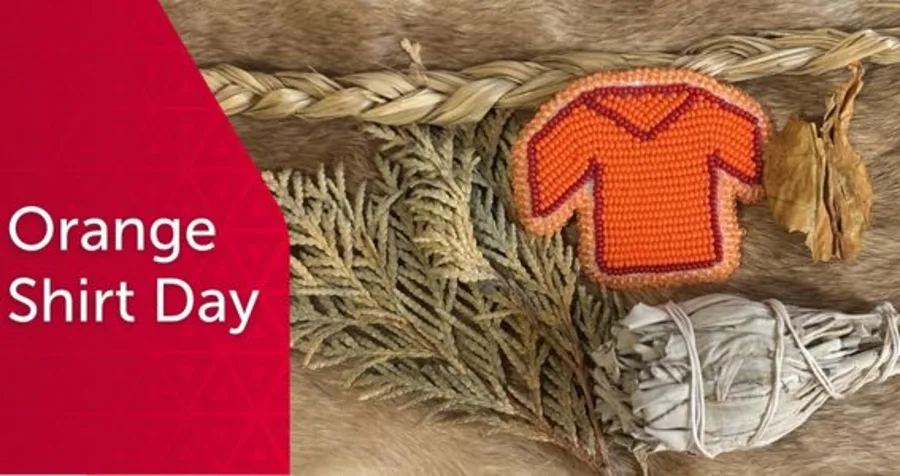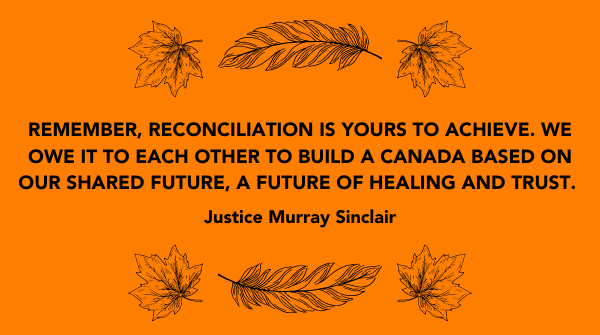Orange Shirt Day 2025. Stolen lives: Children taken, families left behind

Orange Shirt Day 2025 and the 10th anniversary of the Truth and Reconciliation Commission of Canada’s final report
This blog mentions violence against Indigenous Peoples, the Residential School system, and intergenerational traumas and may be triggering. Please take care of yourself. The Indian Residential School Survivors Society (IRSSS) is available to survivors and their families at any time. Call 1-800-721-0066 or 1-866-925-4419 to access the IRSSS 24-7 crisis line. Additional supports for Indigenous Peoples across Canada can be found via the Hope for Wellness Help Line at 1-855-242-3310. First Nations, Inuit, and Métis youth can text 686868 for access to Indigenous volunteer crisis responders (via the Crisis Text Line powered by Kids Help Phone), and adults can access this same service by messaging 741741.
By Christina Sanakidis, Manager of Diversity, Equity, Inclusion & Belonging
The Truth and Reconciliation Commission of Canada
Between 2009 and 2015, the Truth and Reconciliation Commission (TRC) of Canada held hundreds of hearings and community events across the country. Survivors were invited to the community events to share their stories about Canada’s Indian Residential Schools and their legacy. The events included ceremonies, cultural performances, and opportunities to gather statements from survivors and witnesses. Hundreds of thousands of people attended, and many more watched via webcast.
Each event was dedicated to one of the Seven Sacred Teachings — love, respect, courage, honesty, wisdom, humility, and truth. There were also more than 400 smaller outreach events and statement-gathering initiatives during this time.
In the end, the commission received nearly 7,000 statements and approximately five million documents from government and church archives. Stories were shared and voices were heard. The TRC used all the information collected to write its final reports and the 94 Calls to Action.
The Indian Residential School system
Beginning in the 1800s, the government established “schools” to assimilate Indigenous children into European/Canadian culture and norms. Indigenous children were removed from their communities and family units and placed in Residential Schools, where they were punished for speaking their languages, used for labour, and forbidden from practising their traditions. Nutrition was inadequate, abuse and neglect were commonplace, and death rates were high.
While the government funded these institutions, Indian Residential Schools were most often operated by Anglican, Catholic, United, and Presbyterian churches.
Residential Schools operated in Canada for more than 150 years. The last federally run schools (Gordon’s Indian Residential School in Saskatchewan and Kivalliq Hall in Rankin Inlet in what is now known as the territory of Nunavut) closed between 1996 and 1997. It’s estimated that 150,000 or more First Nations, Inuit, and Métis children attended Residential Schools during this period. Phyllis Webstad was one of those children.
Phyllis’s story and the creation of Orange Shirt Day
Phyllis Webstad, from the Stswecem’c Xget’tem First Nation (Canoe Creek Indian Band), had just turned 6 years old when she was taken to St. Joseph Mission Residential School near what’s currently called Williams Lake in British Columbia. She remembers picking out a bright orange shirt with her grandmother and feeling excited about it and about going to school. When she arrived, Phyllis was stripped of her orange shirt and her clothing was taken away. The colour orange remained a symbol of that experience for her.
In 2013, Phyllis’s story became the centre of Orange Shirt Day, which was first started as a legacy of the St. Joseph Mission Residential School Commemoration Project and Reunion events. Orange Shirt Day, observed on September 30, was also designated as the National Day for Truth and Reconciliation in 2021.
Please watch or read Phyllis’s story in her own words.
A decade of Calls to Action
2025 marks 10 years since the TRC published its final reports and 94 Calls to Action. Governments, institutions, and individuals have been given 94 concrete actions to address the negative impacts of Residential Schools and advance meaningful reconciliation. Yet, the Yellowhead Institute refers to the last 10 years as “a decade of disappointment.” That’s because only 15 calls to action have been completed.
That 16% completion rate speaks to the complex, generational nature of the work. The TRC commissioners knew that meaningful reconciliation would require not just changes to policy, but deep and fundamental shifts in how this nation understands itself and treats Indigenous Peoples.
While much work lies ahead, we acknowledge the key developments of the last decade and celebrate the milestones that have brought progress, healing, language revitalization, and an increase in Indigenous voices in media.
The commissioners of the TRC knew that this work of unravelling centuries of colonial systems would take generations. Yet, that’s no reason to be passive. The Calls to Action remain an essential guide for ongoing progress, and we are all responsible for acting to bring truth to light and move collectively towards restitution and healing.
As we mark the 10th anniversary of the TRC’s final reports, we must take ownership of the work, learn more, and take action. Let’s nurture the alliances, relationships, and partnerships, nation to nation, as envisioned by the TRC.
Actions and resources
We encourage readers to engage with the resources linked within this blog and listed below. If you’ve learned something new, share it with someone else. Together, we can advance reconciliation through actions.
- Examine reconciliation, its meaning and applications.
- Research the treaty lands where you live.
- Use this map to find out if there was an Indian Residential School near you.
- Read the final reports and the 94 Calls to Action to become familiar with the ongoing traumatic and intergenerational impacts of this system.
- Seek out stories of resistance and defiance.
- Look for and attend Indigenous-led events in your area (many municipalities in the Greater Toronto Area will be hosting events in honour of Orange Shirt Day and the National Day for Truth and Reconciliation).
- Diversify the media you consume by tuning into more Indigenous films, news, podcasts, and music.
- Visit the National Centre for Truth and Reconciliation's website and register for one of their 2025 Lunch and Learn webinars.

This blog post is dedicated to the Honourable Justice Murray Sinclair Baa, who transitioned to the spirit world in November 2024. Mazina Giizhik (The One Who Speaks of Pictures in the Sky) was a fourth-degree Midewinini, Road Chief, and Western Doorway Chief of the Three Fires Midewiwin Lodge. He was a lawyer, associate chief justice, Canadian senator, chancellor of Queen’s University, and chair of the Truth and Reconciliation Commission. We honour his indelible legacy on the path of Indigenous truth-telling and reconciliation in Canada, profoundly shaping the lives of First Nations, Inuit, and Métis Peoples, and influencing Canada’s national conscience. His leadership helped foster healing by ensuring these stories were heard, honoured, and remembered. He led with fairness, respect, and dignity. His legacy continues to lead us in this work.
Aanawi gigashkendaamin gaawiin ayaasii omaa noongom, gikendaamang geyabi bimaadizid ezhi-mikwenimangid.
Though we may still be sad that he is not here in body, we know that his spirit lives on in our hearts and minds.
Niibina miigewinan gigii-miizhigonaan.
He gave us many gifts.
Daga giwii-bimaadiziyang ezhi-gii-bimaadizid:
May we bring those gifts into reality by enacting them:
gikendaasoyang
being intelligent,
nibwaakaayang
being wise,
debweyang
being sincere,
miinawaa debwe'endamang ingoding bizaanateg akiing.
and desiring justice and peace in the world.
— Adapted from an Ojibwe prayer of remembrance written by Nancy Morehead in 2022.
















